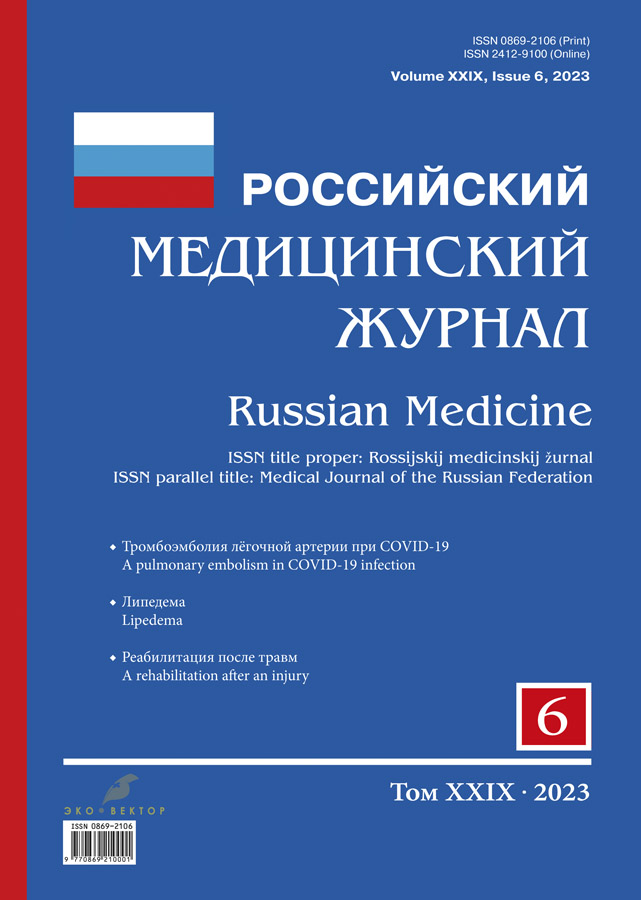Lipedema: a professional community's view
- 作者: Artemova A.S.1, Markin S.M.2, Kravtsov P.F.3
-
隶属关系:
- Multidisciplinary Medical and Diagnostic Centre Lakhta Klinika
- Saint Petersburg Clinical Hospitaln Academy of Sciences
- Samara State Medical University
- 期: 卷 29, 编号 6 (2023)
- 页面: 467-474
- 栏目: Original Research Articles
- ##submission.dateSubmitted##: 29.10.2023
- ##submission.dateAccepted##: 21.11.2023
- ##submission.datePublished##: 13.12.2023
- URL: https://medjrf.com/0869-2106/article/view/622806
- DOI: https://doi.org/10.17816/medjrf622806
- ID: 622806
如何引用文章
详细
BACKGROUND: Lipedema is a chronic disease characterized by abnormal growth of subcutaneous fatty tissue. More than 10% of women have varying degrees of lipedema. Despite the high prevalence of this pathology, to date, there are no full-fledged clinical guidelines, and only sporadic publications have devoted to this disease in the literature.
AIM: To determine the level of immersion of members of the professional community in the diagnosis and treatment of lipedema.
METHODS: Within the framework of the online educational event “Lipedema: 2023” held on the platform “Actual Phlebology” on 22.08.23, 74 physician participants anonymously answered 14 questions on the diagnosis and treatment of patients with lipedema.
RESULTS: In this study, 83.8% of the respondents adhered to the hereditary theory of lipedema development. Only one obvious feature of lipedema, the presence of bilateral symmetrical disproportionate proliferation of adipose tissue on the extremities, was reported by the absolute majority (98.6%) of the specialists interviewed. Less than half of the professional participants noted features such as a feeling of tightness and an excessive tendency to hematoma formation with worsening of symptoms overnight. More than half of the respondents (54.1%) admitted that they were unfamiliar with the classification of lipedema. The main method of conservative treatment of lipedema was considered therapeutic exercise by 74.3% of the respondents. The most popular method of surgical treatment of lipedema is lymphatic liposuction, and which 56.8% of the participants of the professional community are ready to offer this to their patients.
CONCLUSION: The professional community is not sufficiently immersed in the diagnosis and treatment of patients with lipedema. The diversity of current scientific evidence on lipedema requires that it be structured in the development of up-to-date national clinical guidelines.
全文:
作者简介
Anastasiya Artemova
Multidisciplinary Medical and Diagnostic Centre Lakhta Klinika
Email: anastasia_artemova@mail.ru
ORCID iD: 0000-0003-4885-8156
SPIN 代码: 7332-1585
phlebologist
俄罗斯联邦, 73, Savushkin St., St. Petersburg, 197183Sergey Markin
Saint Petersburg Clinical Hospitaln Academy of Sciences
Email: 89052029192@rambler.ru
ORCID iD: 0000-0002-4026-3863
SPIN 代码: 1883-6613
MD, Cand. Sci. (Med.)
俄罗斯联邦, 194017, St. Petersburg, 72, Lit.A, Toreza AvePavel Kravtsov
Samara State Medical University
编辑信件的主要联系方式.
Email: kravtsovpf@mail.ru
ORCID iD: 0000-0002-1283-5342
SPIN 代码: 4656-0218
Scopus 作者 ID: 35345085200
MD, Cand. Sci. (Med.)
俄罗斯联邦, 165b Karla Marksa avenue, 443086 Samara参考
- Aday AW, Donahue PM, Garza M, et al. National survey of patient symptoms and therapies among 707 women with a lipedema phenotype in the United States. Vasc Med. 2023;1358863X231202769. doi: 10.1177/1358863X231202769
- Daftuar F, Eakin G, Galia S, et al. Lipedema research roadmap. OSF Preprints. 2023. doi: 10.31219/osf.io/bx6rt
- Quirós Siniterra de Vásquez L, Uclés Villalobos V. Lipedema: what we should know. Revista de la Facultad de Medicina de la Universidad de lberoamérica. 2022;1(1). (In Spain). doi: 10.54376/rcmui.v1i1.113
- Kruppa P, Georgiou I, Biermann N, et al. Lipedema-pathogenesis, diagnosis, and treatment options. Dtsch Arztebl Int. 2020; 117(22-23):396–403. doi: 10.3238/arztebl.2020.0396
- https://actual-phlebology.ru/ [internet]. Topical Phlebology. Lipidemia: update 2023. Available from: https://actual-phlebology.ru/afonlains/lipedema-aktualizatsiya-2023/ (In Russ).
- Poojari A, Dev K, Rabiee A. Lipedema: insights into morphology, pathophysiology, and challenges. Biomedicines. 2022;10(12):3081. doi: 10.3390/biomedicines10123081
- Ernst AM, Bauer H, Bauer HC, et al. Lipedema research-quo vadis? J Pers Med. 2022;13(1):98. doi: 10.3390/jpm13010098
- Buso G, Depairon M, Tomson D, et al. Lipedema: a call to action! Obesity (Silver Spring). 2019;27(10):1567–1576. doi: 10.1002/oby.22597
- Wiedner M, Aghajanzadeh D, Richter DF. Lipedema — basics and current hypothesis of pathomechanism. Handchir Mikrochir Plast Chir. 2018;50(6):380–385. (In Germany). doi: 10.1055/a-0767-6842
- Strohmeier K, Hofmann M, Jacak J, et al. Multi-level analysis of adipose tissue reveals the relevance of perivascular subpopulations and an increased endothelial permeability in early-stage lipedema. Biomedicines. 2022;10(5):1163. doi: 10.3390/biomedicines10051163
- Cornely M, Hägerling R. Lymphology and dermatology: why should these two medical specialties be honored in a special issue? Dermatologie (Heidelb). 2023;74(8):563–565. (In Germany). doi: 10.1007/s00105-023-05190-x
- Tartaglione G, Visconti G, Bartoletti R, et al. Rest/stress intradermal lymphoscintigraphy in diagnosis of lipedema. World J Nucl Med. 2020;19(4):376–381. doi: 10.4103/wjnm.WJNM_5_20
- Schiltz D, Tschernitz S, Ortner C, et al. Adipose tissue in multiple symmetric lipomatosis shows features of brown/beige fat. Aesthetic Plast Surg. 2020;44(3):855–861. doi: 10.1007/s00266-020-01666-6
- Hansdorfer-Korzon R, Czerwińska M, Teodorczyk J, Szamotulska J. Assessment of lipoedema awareness among polish women-online survey study. BMC Womens Health. 2023;23(1):457. doi: 10.1186/s12905-023-02614-7
- Torre YS, Wadeea R, Rosas V, Herbst KL. Lipedema: friend and foe. Horm Mol Biol Clin Investig. 2018;33(1). doi: 10.1515/hmbci-2017-0076
- Wright T, Scarfino CD, O’Malley EM. Effect of pneumatic compression device and stocking use on symptoms and quality of life in women with lipedema: a proof-in-principle randomized trial. Phlebology. 2023;38(1):51–61. doi: 10.1177/02683555221145779
- Vaughan BF. CT of swollen legs. Clin Radiol. 1990;41(1):24–30. doi: 10.1016/s0009-9260(05)80927-4
- Cellina M, Gibelli D, Soresina M, et al. Non-contrast MR lymphography of lipedema of the lower extremities. Magn Reson Imaging. 2020;71:115–124. doi: 10.1016/j.mri.2020.06.010
- Russell PS, Velivolu R, Maldonado Zimbrón VE, et al. Fluorescent tracers for in vivo imaging of lymphatic targets. Front Pharmacol. 2022;13:952581. doi: 10.3389/fphar.2022.952581
- Crescenzi R, Donahue PMC, Weakley S, et al. Lipedema and dercum’s disease: a new application of bioimpedance. Lymphat Res Biol. 2019;17(6):671–679. doi: 10.1089/lrb.2019.0011
- Baumgartner A, Hueppe M, Meier-Vollrath I, Schmeller W. Improvements in patients with lipedema 4, 8 and 12 years after liposuction. Phlebology. 2021;36(2):152–159. doi: 10.1177/0268355520949775
- Singh K, Kania T, Kimyaghalam A, et al. How i do it: radical debulking of lower extremity end-stage lymphedema. J Vasc Surg Cases Innov Tech. 2023;9(3):101238. doi: 10.1016/j.jvscit.2023.101238
补充文件






